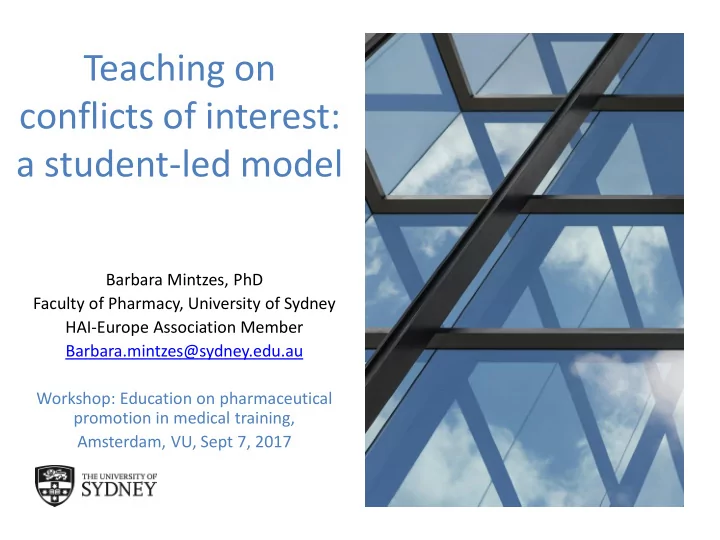

Teaching on conflicts of interest: a student-led model Barbara Mintzes, PhD Faculty of Pharmacy, University of Sydney HAI-Europe Association Member Barbara.mintzes@sydney.edu.au Workshop: Education on pharmaceutical promotion in medical training, Amsterdam, VU, Sept 7, 2017
Financial disclosure • No pharmaceutical industry funding • Expert witness on two Canadian class action suits against pharmaceutical companies 2
What I will cover • Addressing the “hidden curriculum” • American Medical Student Association (AMSA) model curriculum on conflicts of interest (COI) • Has education been shown to be effective? 3
Exposure to marketing is widespread 4 Austad et al. PLoS Med 2011; 8(5): e1001037
Medical students’ exposures and attitudes n=32 studies in 14 countries • Frequent exposure to marketing throughout training • More contact in clinical than pre-clinical years • More restrictive policies, more skepticism • 62 to 86% felt inadequately educated on interactions Austad et al. PLoS Med 2011; 8(5): e1001037 5
Funding of faculty members 6 http://www.cbc.ca/news/health/doctors-pharmaceutical-funding-1.4164625
Taylor R, Giles J. Cash Interests Taint 7 Drug Advice. Nature 2005; 437 : 1070-1
Questionable content of an industry-supported medical school lecture series: a case study Persaud N, Journal of Medical Ethics 2013; 0: 1-5 8
Jarvinen et al. JGIM 2015; 277: 662-673
A need for institutional change 10
11
American Medical Students Association 12
http://amsascorecard.org/ 13
AMSA PharmFree ScoreCard “Just Medicine” campaign • 2007 – first public reporting of medical faculty COI policies • 2008 collaborated with Pew Prescription Project to develop a systematic “scorecard” with 11 domains; 4 -point scale • Annual assessments 2008 to 2013 • Influence on policy: by 2013, 26% had an A vs 5% in 2008 • In 2014, ScoreCard revised: – Increased from 11 to 14 domains – Curriculum criteria strengthened: “comprehensive curriculum mirroring AMSA best practices” 14
15
AMSA ScoreCard • In 2016(n=173): medical faculty grade A (24%); B (44%), C (16%). incomplete 16% – Curriculum on conflicts of interest: 25% – No gifts : 54% – No industry-funded meals: 24% – No Faculty on company speakers’ bureaus: 49% 16
Student reports versus faculty policies Yeh et al. PLoS Med 2014; 11 (10): e1001743 17
Model curriculum Smith SR, Hams M, Wilkinson W. 2013 https://www.communitycatalyst.org/resources/publications/document/CC-Toolkit-1-Curriculum-FINAL.pdf Collaboration Pew Charitable Trust, AMSA, and National Physicians’ Alliance 18
AMSA model curriculum Three main learning objectives: 1) Understand the nature of conflicts of interest and how they pertain to the practice of medicine; 2) Recognize how industry can impact clinical care and develop strategies to mitigate the negative influences; and 3) Properly manage industry relations to maximize patient and societal benefit. “Arming physicians with a healthy dose of skepticism about whatever they hear is probably one of the most powerful lessons that medical education can instill.” - American Association of Medical Colleges (AAMC) Task Force on Industry Funding of Medical Education, 2008 https://www.amsa.org/wp-content/uploads/2015/03/ModelPharmFreeCurriculum.pdf 19
AMSA model curriculum Five recommended competencies: 1. Professionalism and conflict of interest 2. Drug and device development 3. Determining drug and device safety and efficacy 4. Marking and physician practice 5. Continuing Medical Education https://www.amsa.org/wp-content/uploads/2015/03/ModelPharmFreeCurriculum.pdf 20
https://www.amsa.org/wp-content/uploads/2015/03/ModelPharmFreeCurriculum.pdf 21
Effective Teaching Methods • “debunking” – get students to evaluate false claims • “putting a face on the problem” – in-person testimony from patients who were harmed • “case - based approach” with small groups. 22
23
How successful is the educational programme on drug promotion at your institution in meeting its goals? (n=262) Mintzes. WHO/HAI survey, 2005 http://apps.who.int/medicinedocs/pdf/s8110e/s8110e.pdf
• 10 studies of educational interventions, 1995 to 2006 • Mainly pre-post intervention (3/10 controlled) • Small-scale interventions, short-term outcomes • Attitudes and knowledge Carroll et al. Pediatrics 2007; 120: e1528 25
26 Yeh et al. Journal of Graduate Medical Education 2015; 7(4): 595-602
In conclusion • AMSA ScoreCard: a student-led initiative for change • Extensive influence on institutional policy • Education on COI embedded in broader policy shifts • Can education change practice? Questions or comments? 27 Barbara.mintzes@sydney.edu.au
Recommend
More recommend